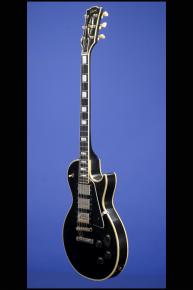A Fantastic 'Players' three pickup 1970 'Special Order' "Black Beauty".
1970 Gibson Les Paul Custom "Black Beauty".
This super rare 'special order' (re-finished in the eighties) three pickup Les Paul Custom Black Beauty weighs just 9.50 lbs. and has nice, fat nut width of 1 11/16 inches and a standard Gibson scale length of 24 3/4 inches. Solid one-piece mahogany body with a three-piece carved maple top. Three-piece mahogany neck with a very fast medium-to-thin profile. White-bound ebony fretboard with 22 thin 'fretless-wonder' frets and inlaid pearl block position markers. Inlaid pearl "Gibson" headstock logo and five-piece pearl split-diamond inlay. "Les Paul Custom" on truss-rod cover. Individual Kluson Super tuners with single-ring Keystone plastic buttons. The serial number "0 0670" is inked on in yellow on the back of the headstock (just like a 1960 guitar). Three patent number humbucking pickups with strong outputs of 7.68k, 7.76k, and 8.51k. Five-layer (black/white/black/white/black) plastic pickguard. Four controls (two volume, two tone) plus three-way selector switch. The potentiometers are stamped " 137 6852" (CTS December 1968). Black plastic bell-shaped "Bell" knobs. ABR-1 Tune-O-Matic non-retainer bridge with metal saddles and separate stud tailpiece. All hardware gold-plated. There is some tarnishing to the gold-plated hardware. Housed in the original Gibson five-latch black hardshell case with purple plush lining (9.00).
Upon close examination of this guitar we have reached the following conclusions: We believe that this is an original 1970 "factory ordered" Custom with three pickup's, the same as the great PAF Black Beauties of the wonderful 1957 - 1961 era. The potentiometers are all dated December 1968 and the pickups are all "patent number" humbuckers with rectangular black labels on the underside. Furthermore it appears from examination under ultra-violet light, that the guitar has been expertly re-finished to exact specification probably during the 1980's. Whatever the story, here is an opportunity for a 'player' to buy a "Peter Frampton" Les Paul Custom for a tiny fraction of the cost of an all original…
We have recently had this fine instrument thoroughly examined by our resident Les Paul expert, Joe Ganzler… his full report is available upon request but here are the 'nuts and bolts' of his opinion…
"Upon careful consideration, I believe this to be a 1970 Gibson Les Paul Custom Electric Guitar, which has had an extensive amount of professional work done on it to make it appear to be a 1960 Gibson Les Paul Custom. This guitar started life as a custom-ordered 3 pickup black Custom that was assembled sometime in 1970; the three piece neck and three piece maple cap clearly point to the 1970-74 era of manufacture. Additional evidence to this is the filled-in factory-impressed serial number/"Made In USA" stamps to the back of the headstock, and the removed factory volute. "Leftover" 1968 potentiometers often appeared into the early '70's on Gibson guitars. Compromised pickup stickers give the "suggestion" of an earlier 1960 Gibson 3-pickup custom, as does the inked-on serial number that begins with a "0". I believe that the instrument was deliberately refinished with a thicker enamel product to mask the work done to the back of the headstock and the three piece neck - enamel is much less prone to shrinkage and "sinking" into the wood. Further evidence that the guitar was refinished in enamel is the headstock face veneer, which is the only part of the instrument that has weatherchecked. Why? Because the lacquer finish to the headstock was NOT removed before refinishing; this will cause the lacquer to weathercheck underneath the enamel in many cases. All other surfaces of the guitar were stripped of the original black lacquer finish prior to the refinishing process. As the final "coup de grace", the luthier applied a serial number that could be construed to be a Gibson 1960 serial number; in all likelihood it is ALSO a variation of this instrument's real (1970) serial number. This was and is commonly done by skilled luthiers in order to "save" the guitar's origin in some fashion. Although heavily modified, the instrument stands on its own as a fine playing, exceedingly rare custom-ordered 3 pickup Les Paul Custom from a desirable era of Gibson manufacture".
"In a move designed to widen the market still further for solidbody guitars, Gibson issued two new Les Paul models in 1954, the Custom and the Junior...The two-pickup Custom looked classy with its all-black finish, multiple binding, block-shaped position markers in an ebony fingerboard, and gold-plated hardware, and was indeed more expensive than the gold-top. Paul said that he chose the black colour for the Custom. 'When you're on stage with a black tuxedo and a black guitar, the people can see your hands move with a spotlight on them. They'll see your hands flying.' The Custom had an all-mahogany body, as favoured by Les Paul himself, rather than the maple/mahogany mix of the gold-top, giving the new guitar a rather mellower tone...The Les Paul Custom was promoted in Gibson catalogues as 'the fretless wonder' because of its use of very low, flat fretwire, different to the wire used on other Les Paul at the time and favoured by some players for the way it helped them play more speedily...The September 1954 pricelist showed the Les Paul Custom at $325 and the Les Paul Junior at $99.50. The gold-top meanwhile had sneaked up to $225" (Tony Bacon, 50 Years of the Gibson Les Paul, p. 25). The Custom was the first Les Paul model to receive the company's Tune-O-Matic bridge, used in conjunction with a separate bar-shaped tailpiece, which offered for the first on Gibsons the opportunity to individually adjust the length of each string, thus improving tuning accuracy.










